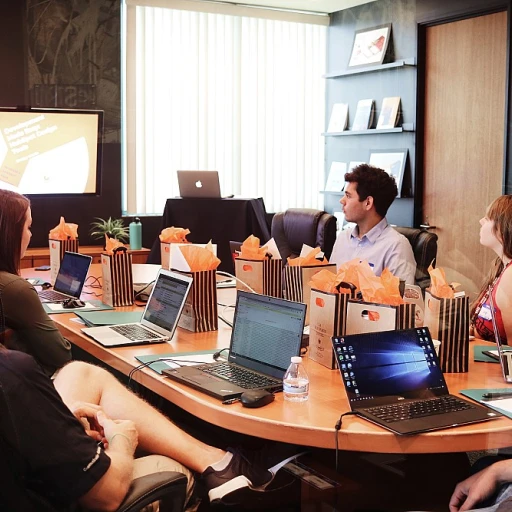
Understanding the Importance of Future Envisioning
The Role of Envisioning in Leadership
In the realm of leadership, crafting a vision for the future is an integral skill that defines success. A compelling vision shapes the path and actions of an organization, guiding participants toward common objectives. Thoughtful future envisioning is more than a mere exercise; it creates a profound impact on work, people, and business.
Leadership in the modern era demands an understanding of the future. It's a process that requires careful consideration of future events, scenarios, and desired changes. Leaders must learn to foresee futures and prepare for a range of potential scenarios. This process includes engaging in futures studies, which emphasize scenario development and horizon scanning, helping leaders to determine their preferred future.
A strong envisioning capability helps leaders articulate a specific future that inspires and motivates. By focusing on future planning, leaders ensure their organizations are not only surviving but thriving amid change. For those seeking to deepen their understanding, explore how you can thrive as a leader amidst change by reading more about embracing transformative thinking here.
Crafting a meaningful vision requires considering the long term and expanding beyond typical mental models. It's about thinking beyond present constraints and enabling change through a comprehensive understanding of potential future scenarios. This type of work emphasizes the importance of life-long learning and adapting one's mental framework to new insights and knowledge over time.
Key Skills for Effective Future Envisioning
Essential Competencies for Visioning the Future
Crafting a resilient future vision requires leaders to hone a diverse array of skills, each serving a pivotal role in the envisioning process. To help leaders effectively conceive a vision for the future that guides their organizations toward better business outcomes, it is crucial to focus on these core competencies.
- Critical Thinking: This skill facilitates questioning current assumptions and envisioning alternative futures. Leaders must be adept at distinguishing between short-term distractions and long-term opportunities, helping them navigate complex scenarios with a clear mind.
- Creative Imagination: Channeling a science fiction mindset enables leaders to break free from conventional thought patterns and visualize specific futures that might initially appear unreachable. Such imaginative efforts are essential for scenario development and envisioning future environments that promote innovation.
- Strategic Planning: The development of a sound strategy is crucial in aligning present goals with future objectives. Through the step process of determining preferred futures, leaders are better equipped to guide their organizations effectively over time.
- Listening and Empathy: Actively engaging with diverse perspectives and understanding collective aspirations aids in forming a comprehensive vision future. By joining participants in co-creating goals, leaders enrich the envisioning process, fostering inclusive decision-making.
- Adaptability: Given that the envisioned future will undergo transformations, leaders must remain flexible, ready to pivot in response to emerging trends, new discoveries, and unforeseen challenges. Adaptability ensures that the vision retains its relevance over the long term.
These key skills are not merely abstract concepts but essential components of a leader's toolkit, as they bolster the capability to anticipate future events and guide organizations through the complexities of change. By embodying these competencies, leaders facilitate a future envisioning process that steers business and personal growth toward the horizon of success.
Overcoming Challenges in Future Envisioning
Confronting the Roadblocks to Visionary Leadership
When leaders endeavor to imagine and shape the future, they often encounter numerous obstacles. These challenges can arise from both personal and organizational dimensions, making the journey to envisioning future scenarios a complex endeavor. One significant hurdle is the inherent human resistance to change. People naturally gravitate towards familiarity and certainty, which can hinder the openness to engage with future thinking and vision future adjustments. Creating a culture that embraces uncertainty requires continuous effort in mental and organizational strategies. Another challenge lies in the ambiguity of specific future scenarios. It demands leaders to possess the ability to navigate multiple potential futures and craft a preferred future. This process, often involving horizon scanning and scenario development, requires a robust thought framework that balances realistic possibilities with innovative foresight. Time constraints also play a crucial role. The everyday demands of business life can impede a leader's capacity to invest in long-term visioning processes. Future work planning must, therefore, join the priority list, incorporating it as an integral part of strategic agendas. Furthermore, the rapid pace of technological and societal changes poses challenges to maintaining relevant visions. Leaders must be vigilant in updating their strategies and practices to incorporate innovation and adjust to evolving future events. A valuable resource in overcoming these hurdles is engaging in futures studies and scenario development workshops. These activities allow participants to practice envision future exercises in a structured setting, often aided by seasoned facilitators. This structured process helps in shaping a vision future that aligns with organizational goals and personal aspirations. In conclusion, overcoming obstacles in future envisioning requires a commitment to fostering a forward-thinking culture. Leaders can help others and themselves embrace uncertainty through continual learning and adaptation. It's a step-by-step process that, when implemented thoughtfully, sets the stage for a transformative business and personal future. Explore the impact of visionary leadership further with this in-depth analysis.Incorporating Innovation into Future Envisioning
Fostering an Innovative Mindset in Future Envisioning
The journey of future envisioning in leadership is incomplete without the crucial element of innovation. This process of crafting a forward-thinking vision requires leaders to integrate novel ideas and approaches, ensuring that the roadmap they construct is not only feasible but also pioneering. An innovative mindset encourages leaders to embrace new perspectives, turning thought into action and transforming scenarios of change into tangible benefits for the business. Innovation often arises from a dynamic interaction with diverse thoughts and disciplines. Embracing future thinking means considering the potential of various futures, including preferred future scenarios that align with one's personal and organizational goals. This alignment helps leaders visualize "better business" outcomes, equipping them to respond adeptly to unwelcome or worst-case scenarios. Through horizon scanning and scenario development, leaders can identify emerging trends that signal an opportunity for change. This proactive approach enables them to position their organizations at the cutting edge, leveraging the foresight gained from this meticulous process to shape a specific future that benefits all participants involved. By imagining future work environments enriched by technological advancements, leaders can create business strategies that are resilient and growth-oriented. An often-underestimated aspect of innovation within future envisioning is the role of science fiction. Futuristic narratives allow leaders to suspend their current reality and explore visionary scenarios, catalyzing creative thought processes that can lead to groundbreaking ideas in business practices. Whether contemplating the long-term implications of privacy policy transformations or the evolution of personal and professional life, the visionary power of speculative fiction can open minds to uncharted possibilities. However, to effectively incorporate innovation, leaders must engage their teams in a step process that cultivates an open environment for dialogue and input. Encouraging contributions from all corners of the organization ensures that multiple perspectives are reflected in the vision future. Involving people in this manner not only strengthens commitment to the envisioned future but also empowers individuals to share and develop their thoughts, promoting collective intelligence. Ultimately, the integration of innovation into the future envisioning process helps bridge the gap between the present and what awaits. Leaders equipped with this capability inspire others to join the collective journey, fostering a culture primed for growth and adaptability. By championing innovation, leaders pave the way for thriving futures.Case Studies: Successful Future Envisioning in Leadership
Real-World Examples of Future Envisioning
Future envisioning is not merely an abstract endeavor; it thrives on real-world applications. Throughout history, there have been numerous influential leaders who have demonstrated the capacity to foresee change and align their personal and business goals with a specific future. These case studies showcase the thought process and dedication required to envision a future that others might not yet see.Pioneering a New Path in Technological Innovation
Leaders in technology sectors have consistently illustrated the importance of a well-crafted vision future. These individuals carefully analyze trends, engage in rigorous scenario development, and use horizon scanning to anticipate future work environments. By thinking beyond the immediate constraints and embracing futures studies, they have innovated products that have altered not only their own organizations but also entire industries.Business Leaders Embracing Change
In the ever-evolving business landscape, some leaders have adeptly used future envisioning to navigate changes and maintain competitive advantage. They have adopted a personal and mental commitment to the envisioning process, preparing for worst-case scenarios while simultaneously creating strategies for preferred futures. By involving key participants in this endeavor, they foster collective thinking that propels the organization towards a shared vision.Urban Planning and Scenario Development
City planning is another arena where successful future envisioning occurs. Urban planners who adeptly employ future scenarios and visions future to craft long-term development plans are instrumental in creating liveable and prosperous environments. Their work often involves detailed planning sessions where future life, environmental sustainability, and social equity are brought into consideration, demonstrating the broad relevance of future envisioning across diverse fields. These instances exemplify how leaders use their unique capacities to foresee and craft visions for a specific future. Beyond serving as a testament to human ingenuity, they highlight the practical applications of horizon scanning and strategic change anticipation, elements crucial to thriving in an unpredictable world.Practical Steps for Leaders to Start Envisioning the Future
Taking Initial Steps toward a Vision-Oriented Future
Embarking on a journey to envision a preferred future involves a methodical approach that helps leaders harness their potential. This process isn't solely about looking ahead – it's about laying the foundation to create impactful change in both personal and professional spheres.Engage in Horizon Scanning
Leaders can begin by scanning the horizon for emerging trends and possible future scenarios. This involves looking beyond the immediate business environment to recognize early signs of change. A well-rounded understanding of societal shifts, technological advancements, and economic factors can significantly contribute to informed decision-making.Develop Scenarios and Future Narratives
Scenario development is pivotal in preparing for various futures. Leaders should invest time in constructing vivid future narratives that encompass potential outcomes and long-term implications. By contemplating various scenarios, ranging from best to worst case, leaders can equip themselves with adaptive strategies.Foster Futures Thinking Skills
Effective envisioning requires honing futures thinking skills. Encouraging participants to actively engage in discussions about future events and specific future possibilities is vital. This mental exercise enhances their ability to foresee changes and anticipate challenges, ultimately guiding them towards a better business environment.Embrace Change and Innovation
Incorporating a mindset that welcomes change and innovation is crucial. Organizations and individuals must be open to evolving their current practices and exploring new avenues. This forward-thinking approach fosters an environment where creativity and innovation thrive.Reflect on Personal and Organizational Vision
Crafting a clear personal vision and understanding its alignment with organizational goals is a significant step in future envisioning. This introspection allows leaders to see how their individual aspirations join and enhance the overarching vision, creating a unified path forward.Implement a Step-by-Step Process
Leaders can follow a systematic step process to bring future envisioning to life:- Define Clear Objectives: Set specific goals for what the envisioned future will look like.
- Gather Insights: Collect data and insights from diverse sources to inform decision-making.
- Engage Stakeholders: Involve key people across the organization to share their thoughts and ideas.
- Create Action Plans: Develop actionable plans that translate visions into concrete steps.
- Monitor Progress: Continuously assess the process and revisit goals to ensure alignment with the vision future.












